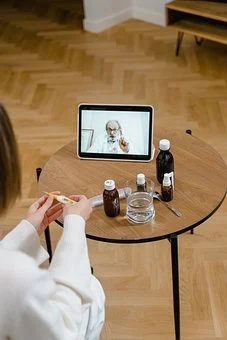.

Telehealth, also known as telemedicine, is the use of digital information and communication technologies to provide remote diagnostics, primary care providers, and treatment providers by medical specialists. Telehealth has been used extensively during the COVID-19 pandemic as a way to provide healthcare services while minimizing exposure to the virus.
Telehealth allows patients to consult with their healthcare providers remotely using video conferencing, phone calls, or other means of communication. This can be useful for people who live in rural areas or who have difficulty accessing traditional healthcare facilities. Telehealth can also be used to provide follow-up care after a hospital stay or to monitor chronic conditions such as blood pressure or heart disease.
There are many benefits of telehealth, including increased access to care and counselling, improved patient outcomes, and reduced costs. Telehealth physicians can also help reduce the spread of infectious diseases by allowing sick patients to consult with their primary care provider without having to travel to a doctor's site or hospital.
The Evidence Base for Telehealth Services: Reassurance in the Face of Rapid Expansion During the COVID-19 Pandemic
Telehealth Tech Vision is licensed under a Creative Commons Attribution 4.0 International License. Telehealth services are covered by most health insurance plans, including Medicare and Medicaid. To find out if your insurance plan covers telehealth services, contact your insurer or visit their website. Telehealth is a convenient and efficient way to receive health care services. It can be used to provide a wide range of services, from preventive care to chronic disease management. Telehealth can also help reduce exposure to infectious diseases, such as the flu or COVID-19.

The Potential of Telehealth
The potential of Telehealth was realized long before the COVID-19 pandemic. However, the pandemic has brought Telehealth to the forefront as a way to provide healthcare services while minimizing exposure to the virus. Telehealth can be used to provide a wide range of services, from preventive care to chronic disease management. Telehealth can also help reduce exposure to infectious diseases, such as the flu or COVID-19. it also secures practitioner and nurse safety.
Personal Health Records
Personal health records (PHRs) are digital versions or data of your medical history that you can access online. PHRs can include information such as your medications, allergies, immunizations, lab results, and medical appointments. You can use a PHR to track your health over time, share data with your healthcare providers, and make informed decisions about your health. There are many benefits of using a PHR, including increased communication between you and your healthcare team, improved coordination of care, and better management of chronic conditions. PHRs can also help you make informed decisions about your health by providing easy access to your medical history.

To get started with a PHR
talk to your doctor or visit the website of a PHR provider. Telehealth services are covered by most health insurance plans, including Medicare and Medicaid. To find out if your insurance plan covers telehealth services, contact your insurer or visit their website. Telehealth is a convenient and efficient way to receive health care services. It can be used to provide a wide range of services, from preventive care to chronic disease management. Telehealth can also help reduce exposure to infectious diseases, such as the flu or COVID-19.
Telehealth is here to stay Telehealth was around long before the COVID-19 pandemic. However, the pandemic has brought Telehealth to the forefront as a way to provide healthcare services while minimizing exposure to the virus. Telehealth can be used to provide a wide range of services, from preventive care to chronic disease management. Telehealth can also help reduce exposure to infectious diseases, such as the flu or COVID-19.
What is Telehealth?
Telehealth is the use of digital information and communication technologies, such as computers and mobile devices, to access health care services remotely. Telehealth can be used to provide a wide range of services, from preventive care to chronic disease management. Telehealth can also help reduce exposure to infectious diseases, such as the flu or COVID-19.

How Telehealth Works
Telehealth involves the use of digital information and communication technologies, such as computers and mobile devices, to access healthcare professional services remotely. Telehealth can be used to provide a wide range of services, from preventive care to chronic disease management. Telehealth can also help reduce exposure to infectious diseases, such as the flu or COVID-19.
COVID-19 Resources developed by AHRQ's Evidence-based Practice Centers Telehealth during the COVID-19 pandemic have the potential to help reduce exposure to the virus while still providing needed healthcare professional services. AHRQ's Evidence-based Practice Centers have developed a number of resources on telehealth, including Guides and Toolkits Telehealth Implementation Guide for Home Health Agencies - This step-by-step guide helps home health agencies implement telehealth services. Telehealth Toolkit for Health Care Professionals - This toolkit provides guidance on how to set up and use telehealth technology, select patients for telehealth care, deliver care via telehealth, and more. Telehealth Policy During the COVID-19 Public Health Emergency
This page provides federal laws and regulations related to the use of telehealth technologies during the COVID-19 pandemic. Telehealth Services can be used to provide a wide range of services, from preventive care to chronic disease management. Telehealth services or mobile health include:- Remote patient monitoring- Virtual visits- E-visits- Store-and-forward technology.
Legal conditions and terms of use
Please review and accept the terms of use before using this site. Telehealth services are provided by licensed healthcare providers.
Privacy Policy AHRQ Telehealth Research
Telehealth research is being conducted to help improve the evidence base for telehealth and to expand the understanding of how telehealth can be used to improve healthcare quality, and provide care, and outcomes. Recent AHRQ-funded telehealth research includes:-
1-The Telehealth Literacy Project:
This project is developing and testing a Telehealth Literacy Assessment to help patients and providers identify gaps in knowledge about telehealth. The assessment will be used to develop patient education materials and provider training modules.
2-Telehealth for Patients With Type 2 Diabetes:
This project is testing whether a telehealth intervention by medical care specialists can improve blood sugar control, weight loss, cholesterol levels, and blood pressure in patients with type 2 diabetes. The intervention includes weekly video visits with a health coach, as well as access to a secure website and mobile app.
. 
3-Telehealth for Children With Autism:
This project is testing whether a telehealth intervention can improve autism symptoms in children ages 3 to 8. The intervention includes weekly video visits with a behavioral health specialist, as well as access to a secure website and mobile app.
4-AHRQ Telehealth Resources
Telehealth Resource Center - The Telehealth Resource Center provides information on telehealth policy, technology, reimbursement, and implementation. Telehealth Research Database - This database allows you to search for AHRQ-funded research by official government organizations on telehealth by keyword, title, author, and other metadata.
5-Telehealth Toolkits and Guides -
These toolkits and guides provide information on how to implement telehealth services, select patient data for telehealth care, deliver care via telehealth, and more.
Telehealth Newsletters -
AHRQ's Telehealth Newsletters provide timely updates on AHRQ telehealth activities, events, and resources. Telehealth Funding Opportunities - This official website's page provides information on AHRQ funding opportunities related to telehealth. Telehealth Webinars - These webinars provide information on a variety of topics related to telemedicine, including implementation, reimbursement, and privacy and security.
Conclusion
If you are considering using telehealth services, it is important to discuss your options with your healthcare provider.
